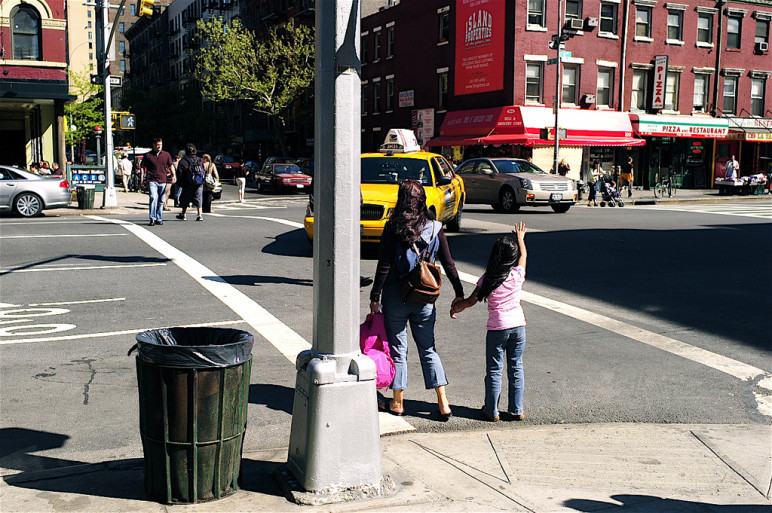Last week I wrote about my experience commuting to work with Yellow Cab vs. Lyft, one of the new on-demand, smartphone-based “ridesharing” services that has recently started operating in Seattle. Personally, my experience with Lyft was much more efficient and pleasant. But that leaves out some important points for policymakers attempting to craft sensible regulations for a growing car-for-hire industry.
For starters, I’m fortunate enough to have the option of owning an iPhone, which gives me the choice to use services like Uber, Lyft, and Sidecar. Those new companies use smartphone apps as their dispatch systems, which put their services out of reach for certain consumers. There are plenty of people who need rides but can’t afford expensive data plans or who are intimidated by new technology.
Also, it’s important to remember that taxis are required to pick everyone up, including all the trips that are undesirable and less profitable: the tourist who doesn’t want to walk five blocks to the Pike Place Market in the rain from their hotel, the Medicaid patient being discharged from the hospital, the person who needs a ride to the airport at 4 a.m. They’re the ones driving the streets every hour of the day, not just cherry picking the morning commute or bar closing time. So it’s important to preserve that equal opportunity service, as well as a robust phone or text-based dispatch system. And in a perfect world, that service should be equally as efficient and respectful as my experience with Lyft.

So regulators have a lot to consider. The first, more straightforward issue is how to ensure that these new, evolving, and unregulated “ridesharing” entries—which can be powerful drivers of sustainability by broadening alternatives to car ownership and single-occupancy trips—are safe for customers.
The second issue is how to allow these new companies to grow that market without giving them unfair advantages over existing taxi, for-hire, and limo drivers and owners, many of them African and South Asian immigrants, who must follow a thicket of rules including license caps, price caps, driver tests, insurance requirements, city vehicle inspections, metering requirements, and other regulations.
[button link='{“url”:”http://www.sightline.org/2013/08/06/taxi-vs-lyft-my-commute/”,”title”:”Did you miss Part 1 of this discussion? Find it here.”}’]
Those include requirements in several Northwest cities that complicated and time-consuming demand studies be conducted before any new taxi licenses are issued (which they rarely, if ever are). This vestigial practice makes no sense. Imagine if we refused to let new doctors practice within the city limits unless they could show that there’s enough demand from sick people to support their business. Or if a hotel developer had to prove there was a shortage of beds for tourists before the city would issue a building permit.
The fact that new ridesharing companies are a) apparently finding people happy to pay them for rides and b) that it can be impossible to get a cab home on a weekend night, and c) that Northwest cities have among the lowest cabs per capita rates in the nation suggests that there probably is a much larger audience of people who would prefer not to drive their own car everywhere. (In Seattle, we should find out next month whether the results of the city’s much-awaited taxi demand study bear out this obvious conclusion.)
So, as policymakers in Seattle and Portland and elsewhere consider how to support a more robust, competitive, and equitable for-hire industry, here are some other general principles to follow:
1. Create more openness and opportunity
We need to move to a system where there are more—not fewer—opportunities for people to reject car ownership or driving alone. Caps on existing taxi and for-hire licenses should be eliminated or phased out to encourage healthy competition and create a more level playing field that gives existing taxi and for-hire drivers the same opportunities to control their own destinies as drivers being hired by Uber, Lyft, and Sidecar (which, in some cases, are one and the same).
At the moment, it is unfair that a whole host of new drivers have started picking up fares in their personal cars when thousands of taxi drivers have been unable to increase their hours or go into business for themselves because of limits on legal taxi licenses. Moreover, those caps have depressed competition, made it possible for poorly run businesses to stay afloat because consumers have few choices, and created an unequal system of haves (owners with precious taxi licenses) and have-nots (drivers who start out every shift $70 or $80 in the hole because they have to lease a licensed cab from a more fortunate owner).
Prying open the taxi market and allowing more open entry begins to solve both problems. If negative consequences arise—such as crowding at taxi stands or a decline in customer service that occurred when Seattle deregulated taxis more than 30 years ago—focus on addressing those problems. Let the market sort out supply and demand.
2. Regulate for health and safety
The new ridesharing companies are more than just glorified carpools. They are operating as businesses and it is entirely reasonable for them to be subject to basic health and safety regulations. The state of California, where many of the new ridesharing companies are based, recently issued proposed regulations, allowing them to operate under a new category of “transportation network companies,” that could be a useful model.
The companies (not the individual drivers) must be licensed by the state, perform criminal background and driving record checks on drivers, establish driver training programs, have a zero tolerance policy for drugs and alcohol, conduct a 19-point inspection on vehicles, and carry a $1 million per-incident liability insurance policy. I’ve not seen a good explanation of who will ensure the companies are following those rules and how that enforcement effort will be funded, which is obviously an important piece of the puzzle. The rules also ban the new companies from accepting airport trips without permission from airport authorities.
As for the current system, if some of the existing health and safety regulations for taxi and for-hire companies are arguably unnecessary, we should streamline them in the interest of fairness. Do we really need Seattle taxi drivers to get medical physicals?

3. Leave no rider behind
Left entirely to its own devices, the for-hire industry would likely be inclined to stop serving some segments of the population who need rides the most, such as the elderly person who needs a five-block (and from the perspective of the taxi drivers, unprofitable) ride to the grocery store.
The new smartphone services also allow drivers to rate customers and screen out requests from customers who aren’t a barrel of laughs. With services that market the ridesharing experience not as a business transaction but as a ride with a cool new friend, it’s not hard to see how the rating system could foster unintended discrimination against riders who are old, or crabby, or non-English speakers, or who just don’t fit in the cool crowd. (The proposed California regulations include requirements for the companies to keep records on refused rides, which are designed to prevent this from happening.)
Some part of the for-hire industry still needs to serve people who need rides at inconvenient hours, or who aren’t traveling that far, or who may not be scintillating conversationalists. The current mandate that taxi companies serve all calls—at least in theory, if not in practice—needs to be preserved in some part of the system, and the drivers who accept this responsibility need to be incentivized or compensated in some way (airport trips seem popular.)
4. Arm consumers with better information
When it comes to price regulation, I’m going to punt on making a recommendation, except to argue for transparency and giving customers better tools and information to make informed choices. Right now, the bewildering array of car-for-hire options that all price trips differently is confusing at best. And I had no idea what my Lyft ride would cost until the end of the ride when my “suggested donation” popped up. Consumers with the time and inclination to comparison shop could benefit if taxi, for-hire, and ridesharing services have more flexibility to compete on price, and if those prices were more readily comparable.

Yet that presumes customers and tourists are always in a position to choose, and in situations like airport and hotel queues that’s not generally the case. One potential solution is to establish maximum fares, letting companies that can provide service for less market themselves accordingly, or to regulate fares in special circumstances such as airport trips.
It’s also important to acknowledge that, at least in Seattle, any scenario that allows more entry and competition would hurt current owners of the roughly 1,100 taxi and for-hire licenses floating around Seattle and King County. Because they’re scarce and they can be sold to new users, current values reportedly range from $40,000 for a county-only license to $360,000 for a cab that can take airport trips. If caps are lifted, the value of those licenses will eventually decline to zero. (Portland doesn’t have this problem because taxi permits essentially are owned by the city and can’t be sold when a current user is done with one.)
Some owners have amassed multiple taxi licenses purely as a business investment and never get behind the wheel. Some are drivers who jumped at the opportunity, and in some cases may have borrowed against homes or from family and friends, to purchase a single license and become their own boss. Those individuals make a compelling emotional case that changing the rules in midstream would unfairly hurt them.
So this is the thorniest political question that regulators, at least in Seattle, must confront. Gradually phasing out license caps might give owners the ability to recoup some of their investment, while signaling to new purchasers that the secondary market for licenses will not continue to escalate. Depending on how the city chooses to regulate new ridesharing companies, though, could also perpetuate a two-tired system that puts a much greater number of taxi drivers at a disadvantage. And then there are the persuasive arguments that the city shouldn’t be in the business of protecting private investments and propping up an inefficient monopoly. In this day and age, it seems like some fairly basic technology upgrades could have radically improved the customer service experience by now, yet taxi dispatch companies apparently had no incentive to do so.
It is easy to see how the for-hire system could be better. It’s less clear how to move from the regulatory system we have now, with limited access and different categories of drivers all following different rules, to the one we want, an industry that works for consumers, offers equal opportunity, and can grow the market for car-less or car-light lifestyles. But using these general principles as guideposts could be a place to start.
For more on taxi regulations, see Sightline’s earlier articles on the topic:
- Freeing Taxis: Unleashing cabs to boost affordable, green transport
- Freeing Taxis, Addendum: A few responses


Comments are closed.